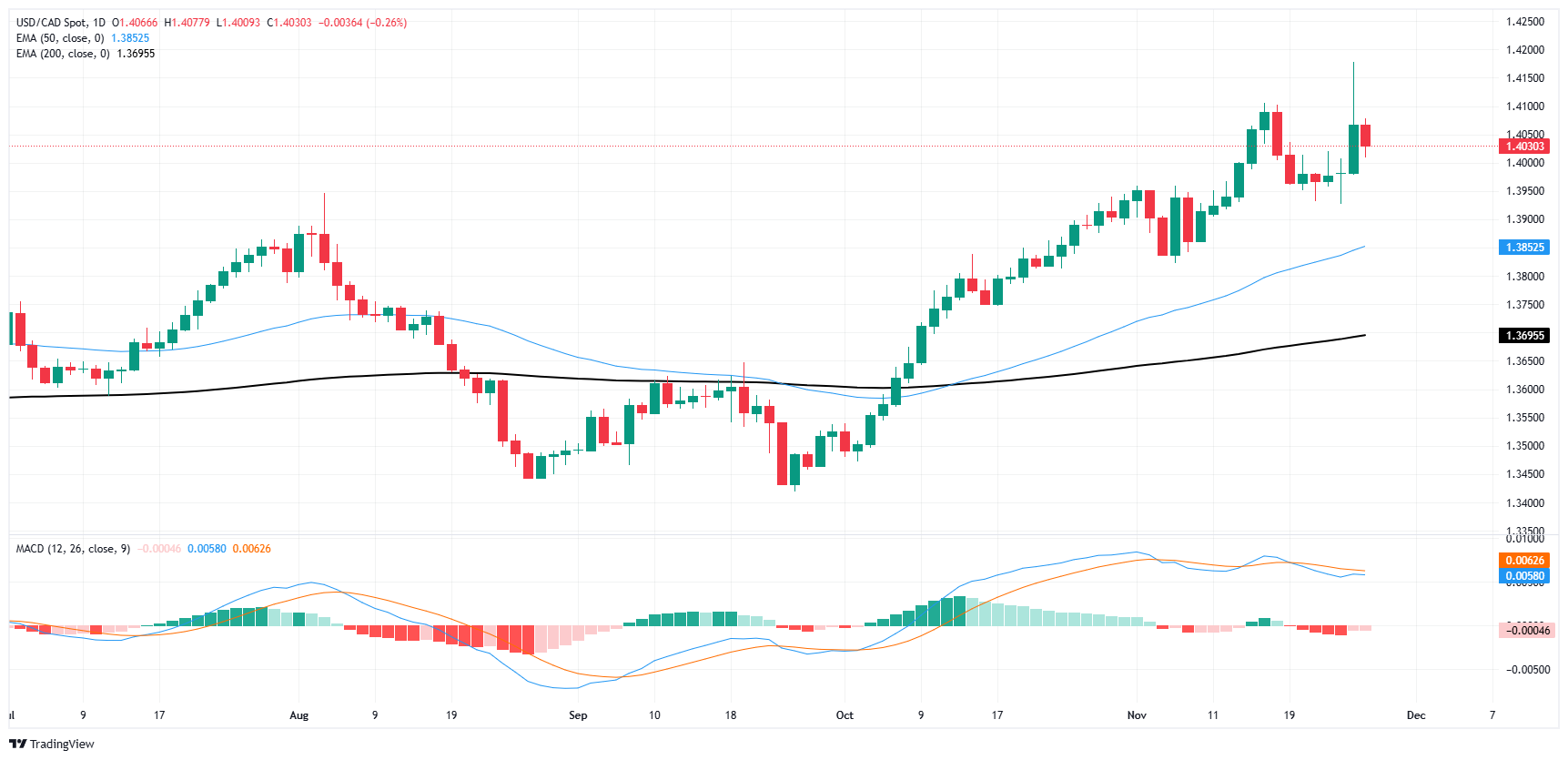- The Canadian Dollar caught a slight bid after falling to multi-year lows.
- Canada remains absent from the economic calendar until Friday.
- The upcoming Thanksgiving holiday in the US will compress market volumes this week.
The Canadian Dollar (CAD) caught a much-needed bid on Wednesday, regaining a small portion of recently lost ground after the Loonie fell to multi-year lows due to a correlated drop in crude oil prices earlier in the week. Investors reduced widespread dollar bids, driving USD/CAD back towards the 1.4000 level.
Canada has been functionally absent from the economic calendar this week, with no significant data releases on the radar until Friday’s quarterly Canadian Gross Domestic Product (GDP) update. US data largely met expectations on Wednesday, keeping market sentiment balanced and giving the Canadian dollar a breather as dollar bids narrow.
Daily Market Summary: Canadian Dollar Regains Ground After Multi-Year Decline
- The Canadian dollar gained a quarter of a percentage point on Wednesday, recovering from the rapid decline to 55-month lows earlier in the week.
- The main market drivers on Wednesday were a broad release of US data as markets rush to close trading for the Thanksgiving holiday on Thursday.
- Markets will also see limited trading hours on Friday, further reducing market volumes during the second half of the trading week.
- US core personal consumption expenditure price index (PCEPI) inflation rose on an annualized basis, but not more than investors expected, keeping market reactions limited.
- Canada’s third-quarter GDP update, scheduled for Friday, is expected to decline to 1.0% on an annualized basis compared to 2.1% previously, while the monthly GDP estimate is forecast to rise counterintuitively to 0.3% from the previous flat figure of 0.0%.
Canadian Dollar Price Forecast
The Canadian Dollar (CAD) reaching the 55-month low this week is seeing a tepid bounce. The CAD has gained an intraday foothold against the US Dollar, bringing the USD/CAD pair back into the contact range of the 1.4000 level. The pair remains stuck on the upside following a broad-based dollar bull run, but technical traders will find it increasingly difficult to ignore the growing potential for a cyclical turn on long-term charts.
USD/CAD Daily Chart
The Canadian Dollar FAQs
The key factors that determine the price of the Canadian Dollar (CAD) are the level of interest rates set by the Bank of Canada (BoC), the price of oil, Canada’s main export product, the health of its economy, inflation and the trade balance, which is the difference between the value of Canadian exports and its imports. Other factors are market confidence, that is, whether investors bet on riskier assets (risk-on) or look for safe assets (risk-off), with the risk-on being positive for the CAD. As its largest trading partner, the health of the US economy is also a key factor influencing the Canadian dollar.
The Bank of Canada (BoC) exerts significant influence over the Canadian Dollar by setting the level of interest rates that banks can lend to each other. This influences the level of interest rates for everyone. The BoC’s main objective is to keep inflation between 1% and 3% by adjusting interest rates up or down. Relatively high interest rates are usually positive for the CAD. The Bank of Canada can also use quantitative easing and tightening to influence credit conditions, with the former being negative for the CAD and the latter being positive for the CAD.
The price of oil is a key factor influencing the value of the Canadian Dollar. Oil is Canada’s largest export, so the price of oil tends to have an immediate impact on the value of the CAD. Generally, if the price of oil rises, the CAD also rises, as aggregate demand for the currency increases. The opposite occurs if the price of oil falls. Higher oil prices also tend to lead to a higher probability of a positive trade balance, which also supports the CAD.
Although inflation has traditionally always been considered a negative factor for a currency, as it reduces the value of money, the opposite has actually happened in modern times, with the relaxation of cross-border capital controls. Higher inflation often leads central banks to raise interest rates, attracting more capital inflows from global investors looking for a lucrative place to store their money. This increases the demand for the local currency, which in the case of Canada is the Canadian Dollar.
The published macroeconomic data measures the health of the economy and may have an impact on the Canadian dollar. Indicators such as GDP, manufacturing and services PMIs, employment and consumer confidence surveys can influence the direction of the CAD. A strong economy is good for the Canadian dollar. Not only does it attract more foreign investment, but it may encourage the Bank of Canada to raise interest rates, resulting in a stronger currency. However, if economic data is weak, the CAD is likely to fall.
Source: Fx Street
I am Joshua Winder, a senior-level journalist and editor at World Stock Market. I specialize in covering news related to the stock market and economic trends. With more than 8 years of experience in this field, I have become an expert in financial reporting.







